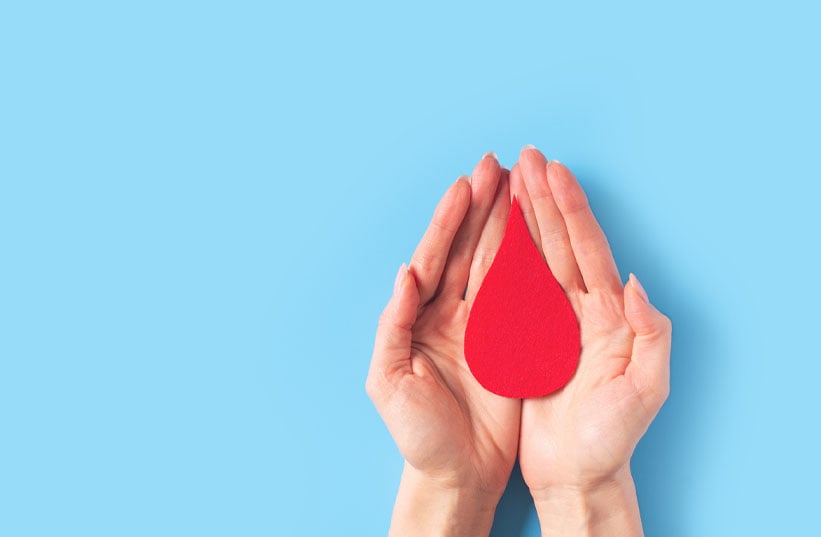Do you ever give blood? According to the Red Cross, every two seconds there’s an American in need of it, requiring roughly 41,000 donations per day. In the U.S., more than 100 million people are eligible to donate, although only about 9 million do so every year (1).
Blood donations help people cope with diseases like sickle cell (affecting more than 90,000 people in the U.S.), and cancer (affecting 14 million (2)), which require frequent blood transfusions. Hospitals also need a continuous supply of fresh blood for surgical patients, laboring mothers, and trauma cases (1,3).
While a necessary and benevolent act, personal trainers, competitive athletes, strength and conditioning specialists, and fitness enthusiasts should be aware that donating blood is not without physical consequences, including a temporary reduction in endurance performance (4,5,6,7) and in some cases, iron-deficiency (8).
Can You Workout After Donating Plasma?
Heed the Red Cross’s advice to give yourself 24 hours rest afterward to allow your plasma levels to restore, and hydrate and fuel well before and after your donation (1).
If you’re an athlete (like a basketball player) that wants to donate blood, it’s completely feasible to do so, but probably best delayed until after your critical training periods. Consider donating during the off-season when training is lighter and performance isn’t an imminent concern (15).
Blood Donation Types and Functions
When giving blood, most donors opt for the more common donation type called “whole blood” donation or some choose a partial donation in which only specific aspects are extracted: plasma, red blood cells (RBCs), or platelets (9-11). During a whole blood donation, blood is taken from the arm and then separated later into its usable parts, which can benefit up to three people (9).
A partial donation is performed nearly the same way except that the donated parts, platelets for example, are machine-separated from the blood, then the remaining parts are returned back to the donors arm (9).
Regardless of donation type, every part of your blood can be (and is, according to the Red Cross) used to help someone in need (9). Here’s how each part of the blood plays a role in your body, and in saving someone’s life.
Red Blood Cells
Red blood cells support metabolism by delivering oxygen (O2) to working tissues, and the integrity of your O2 delivery system predicts your overall work capacity, or VO2max (5). Therefore, the more RBCs you have, the more oxygen you can deliver, thus enhancing your ability to do work. Endurance athletes who dope with erythropoietin (EPO), a hormone that stimulates the synthesis of new RBCs, know this first-hand because it gives them an edge (though banned by WADA) on their competition (5). On the other end of the spectrum, a trauma victim who’s experienced substantial blood loss relies on replacement RBCs simply to keep her organs alive.
RBCs have a short shelf-life of 42 days, which underscores the need for regular donation (9).
Plasma
Plasma is the water-based netting that contains all of the other blood parts: red and white blood cells, platelets, and proteins. Donated plasma (also called cryoprecipitate - its frozen state that can last up to one year (1)) can be used for either blood transfusions, or to manufacture products that help people with blood-deficiency diseases, like hemophilia – a genetic disorder in which a person’s blood lacks a specific clotting factor found in normal plasma (11).
Platelets
When a blood vessel is damaged, platelets gather around the injury site, and activate plasma clotting factors to stop the bleeding. Donated platelets are routinely given to burn victims, and patients who’ve undergone heart surgery, organ and bone marrow transplants (12). They’re also frequently supplied to cancer patients in chemotherapy treatment (13).
Donating Blood and Endurance Performance
Your body contains approximately10 pints of blood, one of which you give away during a “whole blood” donation. One pint of blood is also referred to as 450-500 ml, or one unit. Donating one-tenth of our blood may seem hefty until you consider that a car crash victim could need up to 100 pints of blood to survive (1)!
After donation, your body goes to work regenerating the lost blood. Your plasma recovers the quickest, in about 24 hours (9). The Red Cross recommends no strenuous exercise during this period until your “fluid” or plasma normalizes (9). Platelets restore next, within a 72-hour period (13). The oxygen carriers or RBCs – unfortunately for athletes - are the slowest to regenerate, taking four to six weeks to fully rebound (9).
The lag in RBC recovery is an obvious indicator that an athlete’s endurance performance will suffer until pre-donation levels are restored. Several studies have reported significant drops in performance measures from 24 hours to two days post-donation in active young adults, including VO2 max, work rate (4,5,6,7), and time to exhaustion (5). Dellweg et al. reported a 9% decrease in VO2 max, and a 13% drop in maximal work rate following a 500-ml whole blood donation (6).
Unsurprisingly, researchers found significant decreases in subjects’ hemoglobin (Hb), too (4,5,6). If you recall from our piece on iron and athletic performance we discussed that Hb is the critical protein found in red blood cells (RBCs), whose function is to transfer oxygen from the lungs to the body’s tissues.
A drop in Hb compromises both the amount of oxygen that can be delivered to working cells, as well as oxygen’s ability to dissociate once it arrives, called diffusing capacity (DO2). Both factors contribute to an overall decrease in VO2 max. Interestingly, one study noted a direct correlation between Hb and VO2 max such that if one is reduced by 5%, a roughly 5% decrease in the other can be expected, and vice versa (5).
Iron-deficiency
Donating blood in some cases may also negatively effects iron status. In a study conducted with 182 Saudi men, subjects showed significant reductions in serum ferritin levels if they donated one unit of blood (450-500 ml) 4-5 times per year (8). Because your body manufactures new hemoglobin from ferritin stores (14), it’s a critical factor influencing new RBC production.
Athletes and non-athletes should therefore consider having their ferritin levels checked if they’re frequent blood donors (15). Another way to reduce your risk is by taking extra care to get enough iron in your diet.
Performance Recovery
So how long post-donation does it take for an athlete’s performance to return? Judd et al. reported in 2011 that its subjects’ performance measures normalized roughly three weeks after giving whole blood (7). While that timeframe may not feel too exhaustive (considering the Red Cross suggests 4-6 weeks for full RBC regeneration (9)), training nearly one month at reduced capacity would almost certainly negatively impact future performances.
References
- Blood facts and statistics. (2016). The American National Red Cross. http://www.redcrossblood.org/learn-about-blood/blood-facts-and-statistics.
- World Cancer Day. (2015). Center for Disease Control and Prevention. http://www.cdc.gov/cancer/dcpc/resources/features/worldcancerday.
- Why should I donate blood? (2016). World Health Organization. http://www.who.int/features/qa/61/en.
- Fritsch, J., Winter, U.J., Reupke, I., Gitt, A.K., Berge, P.G., & Hilger, H.H. (1993). Effect of a single blood donation on ergo-spirometrically cardiopulmonary performance capacity of young healthy probands. Zeitschrift fur Kardiologie, 82(7). Abstract. http://www.ncbi.nlm.nih.gov/pubmed/8379242.
- Burnley, M., Roberts, C.L., Thatcher, R., Doust, J.H., & Jones, A.M. (2006). Influence in blood donation on O2 uptake kinetics, peak O2 uptake, and time to exhaustion during severe-intensity cycle exercise in humans. Experimental Physiology, 91(3). http://onlinelibrary.wiley.com/doi/10.1113/expphysiol.2005.032805/full.
- Dellweg, D., Siemon, K., Mahler, F., Appelhans, P., Klauke, M., & Kohler, D. (2008). Cardiopulmonary exercise testing before and after blood donation. Pneumologie, 62(6), Abstract. http://www.ncbi.nlm.nih.gov/pubmed/18535983.
- Judd, TB., Cornish, S.M., Barss, T.S., Oroz, I., Chilibeck, P.D. (2011). Time course for recovery of peak aerobic power after blood donation. Journal of Strength & Conditioning Research, 25(11). http://journals.lww.com/nsca-jscr/pages/articleviewer.aspx?year=2011&issue=11000&article=00014&type=abstract.
- Abdullah, S.M. (2011). The effect of repeated blood donations on the iron status of male Saudi blood donors. Blood Transfusion, 9(2). http://www.ncbi.nlm.nih.gov/pmc/articles/PMC3096860.
- Donation FAQs. (2016). The American National Red Cross. http://www.redcrossblood.org/donating-blood/donation-faqs.
- Plasma donation. (2016). The American National Red Cross. http://www.redcrossblood.org/donating-blood/types-donations/plasma.
- (2016). Give Blood. https://www.blood.co.uk/why-give-blood/how-blood-is-used/blood-components/plasma.
- Donating platelets. (2016). Bloodworks Northwest. https://www.psbc.org/programs/platelets.htm.
- Ruel, J. (2011). Whole blood & platelets: what’s the difference? Stanford Blood Center. http://bloodcenter.stanford.edu/blog/archives/2011/07/whole-blood-pla.html.
- Wilber, R. (2004). Altitude training and athletic performance. Champaign, IL: Human Kinetics.
- Davis, John. (2015). How donating blood impacts your training and racing (and 4 strategies to mitigate the impact). RunnersConnect. http://runnersconnect.net/running-injury-prevention/blood-donation-running-performance.
















